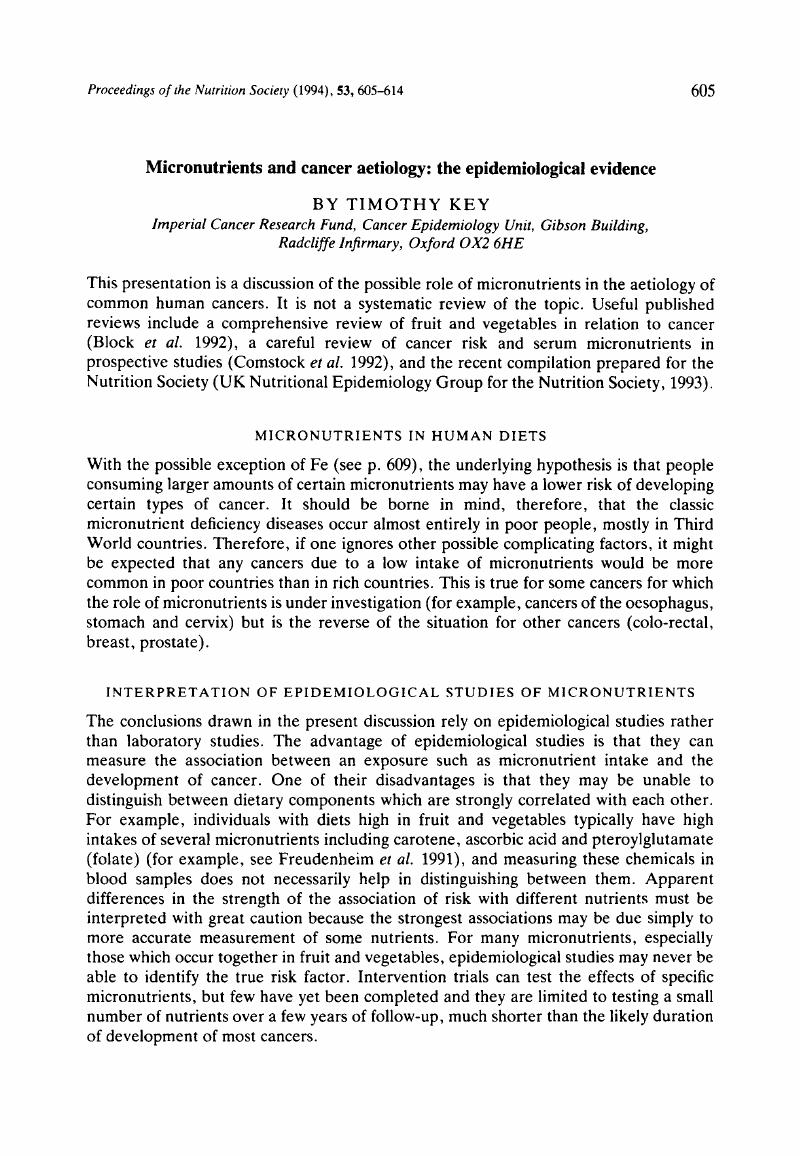Crossref Citations
This article has been cited by the following publications. This list is generated based on data provided by Crossref.
Combs, Gerald F.
1996.
Should Intakes with Beneficial Actions, Often Requiring Supplementation, Be Considered for RDAs?.
The Journal of Nutrition,
Vol. 126,
Issue. ,
p.
2373S.
Velásquez-Meléndez, Gustavo
Salas Martins, Ignez
Cervato, Ana Maria
Fornés, Nélida Schmid
and
Marucci, Maria de Fátima Nunes
1997.
Consumo alimentar de vitaminas e minerais em adultos residentes em área metropolitana de São Paulo, Brasil.
Revista de Saúde Pública,
Vol. 31,
Issue. 2,
p.
157.
Scott, Gerald
1997.
Antioxidants in Science, Technology, Medicine and Nutrition.
p.
262.
Lalos, A.
Eisemann, M.
and
Lalos, O.
1997.
Personality differences between endometrial and cervical cancer patients in relation to sexual behavior.
Journal of Psychosomatic Obstetrics & Gynecology,
Vol. 18,
Issue. 1,
p.
53.
Scioscia, Kenneth A.
Snyderman, Carl H.
and
Wagner, Robin
1998.
Altered serum amino acid profiles in head and neck cancer.
Nutrition and Cancer,
Vol. 30,
Issue. 2,
p.
144.
Wallström, Peter
Wirfält, Elisabet
Lahmann, Petra H
Gullberg, Bo
Janzon, Lars
and
Berglund, Göran
2001.
Serum concentrations of β-carotene and α-tocopherol are associated with diet, smoking, and general and central adiposity.
The American Journal of Clinical Nutrition,
Vol. 73,
Issue. 4,
p.
777.
Iodice, Patrizia
Federico, Alessandro
Federico, Pierluigi
Del Rio, Antonio
Mellone, Maria Cristina
Federico, Pasquale
and
Catalano, Giuseppe
2001.
Does polychemotherapy with 5-fluorouracil, methotrexate, and L-folinic acid influence the selenium, zinc, and copper serum levels in cancer of digestive tract?.
The Journal of Trace Elements in Experimental Medicine,
Vol. 14,
Issue. 1,
p.
73.
Askling, Johan
Linet, Martha
Gridley, Gloria
Halstensen, Trond S.
Ekström, Karin
and
Ekbom, Anders
2002.
Cancer incidence in a population-based cohort of individuals hospitalized with celiac disease or dermatitis herpetiformis.
Gastroenterology,
Vol. 123,
Issue. 5,
p.
1428.
Monroe, Kristine R.
Hankin, Jean H.
Pike, Malcolm C.
Henderson, Brian E.
Stram, Daniel O.
Park, Sohee
Nomura, Abraham M. Y.
Wilkens, Lynne R.
and
Kolonel, Laurence N.
2003.
Correlation of Dietary Intake and Colorectal Cancer Incidence Among Mexican-American Migrants: The Multiethnic Cohort Study.
Nutrition and Cancer,
Vol. 45,
Issue. 2,
p.
133.
Green, Peter H.R
Fleischauer, Aaron T
Bhagat, Govind
Goyal, Rishi
Jabri, Bana
and
Neugut, Alfred I
2003.
Risk of malignancy in patients with celiac disease.
The American Journal of Medicine,
Vol. 115,
Issue. 3,
p.
191.
Sakaguchi, Shigeko
Yokokawa, Yoshiharu
Hou, Jun
Zhang, Xiu-Lan
Li, Xiang-Ping
Li, Shao-Sen
Li, Xiao-Xian
Zhu, De-Chen
Kamijima, Michihiro
Yamanoshita, Osamu
and
Nakajima, Tamie
2005.
Environmental Exposure and p53 Mutations in Esophageal Cancer Patients in Areas of Low and High Incidence of Esophageal Cancer in China.
The Tohoku Journal of Experimental Medicine,
Vol. 207,
Issue. 4,
p.
313.
Cereda, Stefano
Cefalo, Graziella
Spreafico, Filippo
Catania, Serena
Meazza, Cristina
Podda, Marta
and
Terenziani, Monica
2006.
Celiac Disease and Childhood Cancer.
Journal of Pediatric Hematology/Oncology,
Vol. 28,
Issue. 6,
p.
346.
Kabat, G C
Miller, A B
Jain, M
and
Rohan, T E
2008.
Dietary intake of selected B vitamins in relation to risk of major cancers in women.
British Journal of Cancer,
Vol. 99,
Issue. 5,
p.
816.
Fundia, Ariela F.
Cottliar, Alejandra S.
La Motta, Graciela
Crivelli, Adriana
Gómez, Juan Carlos
Slavutsky, Irma R.
and
Larripa, Irene B.
2008.
Analysis of genomic instability in adult-onset celiac disease patients by microsatellite instability and loss of heterozygosis.
European Journal of Gastroenterology & Hepatology,
Vol. 20,
Issue. 12,
p.
1159.
Lee, Sang-Ah
Lee, Kyoung-Mu
Lee, Seung-Joon
Yoo, Keun-Young
Park, Sue Kyung
Noh, Dong-Young
Ahn, Sei-Hyun
and
Kang, Daehee
2010.
Antioxidant Vitamins Intake, Ataxia Telangiectasia Mutated (ATM) Genetic Polymorphisms, and Breast Cancer Risk.
Nutrition and Cancer,
Vol. 62,
Issue. 8,
p.
1087.
Bassett, Julie K.
Severi, Gianluca
Hodge, Allison M.
Baglietto, Laura
Hopper, John L.
English, Dallas R.
and
Giles, Graham G.
2012.
Dietary intake of B vitamins and methionine and prostate cancer incidence and mortality.
Cancer Causes & Control,
Vol. 23,
Issue. 6,
p.
855.
Lee, Sang-Ah
Lee, Kyoung-Mu
Yoo, Keun-Young
Noh, Dong-Young
Ahn, Sei-Hyun
and
Kang, Daehee
2012.
Combined effects of antioxidant vitamin and NOS3 genetic polymorphisms on breast cancer risk in women.
Clinical Nutrition,
Vol. 31,
Issue. 1,
p.
93.
Bassett, J K
Hodge, A M
English, D R
Baglietto, L
Hopper, J L
Giles, G G
and
Severi, G
2012.
Dietary intake of B vitamins and methionine and risk of lung cancer.
European Journal of Clinical Nutrition,
Vol. 66,
Issue. 2,
p.
182.
Bassett, Julie K.
Severi, Gianluca
Hodge, Allison M.
Baglietto, Laura
Hopper, John L.
English, Dallas R.
and
Giles, Graham G.
2013.
Dietary Intake of B Vitamins and Methionine and Colorectal Cancer Risk.
Nutrition and Cancer,
Vol. 65,
Issue. 5,
p.
659.
Bassett, Julie K.
Baglietto, Laura
Hodge, Allison M.
Severi, Gianluca
Hopper, John L.
English, Dallas R.
and
Giles, Graham G.
2013.
Dietary intake of B vitamins and methionine and breast cancer risk.
Cancer Causes & Control,
Vol. 24,
Issue. 8,
p.
1555.



